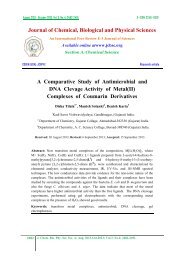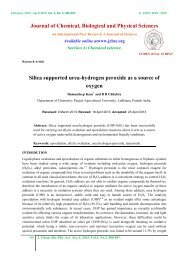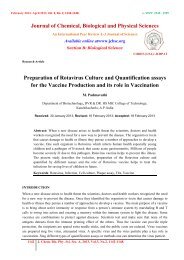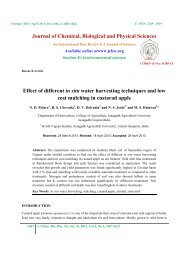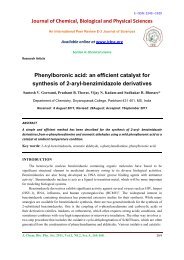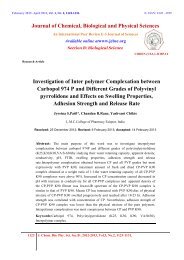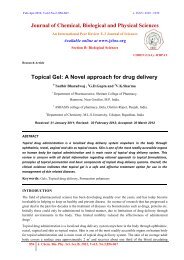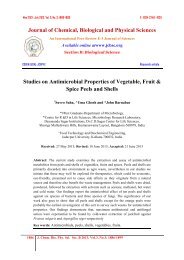Studies on Synthesis, Characterization and Antibacterial Activity of ...
Studies on Synthesis, Characterization and Antibacterial Activity of ...
Studies on Synthesis, Characterization and Antibacterial Activity of ...
- No tags were found...
You also want an ePaper? Increase the reach of your titles
YUMPU automatically turns print PDFs into web optimized ePapers that Google loves.
<str<strong>on</strong>g>Studies</str<strong>on</strong>g>...Purav Talaviya et al.Table-3: <strong>Antibacterial</strong> activity <strong>of</strong> coordinati<strong>on</strong> PolymersCompounds Gram +ve Gram –veBacillus Staphylococcus klebsiella Salm<strong>on</strong>ella E.coliSubtilis Aureuspromioe TyphiPBDQ 20 19 22 22 23(Cu BDQ(H 2 O) 2 ) n 34 36 31 32 29(Co BDQ(H 2 O) 2 ) n 32 30 24 23 23(Ni PBDQ(H 2 O) 2 ) n 30 26 26 25 26(Mn PBDQ(H 2 O) 2 ) n 31 33 24 24 22(Zn PBDQ(H 2 O) 2 ) n 30 32 29 32 23Table-4: Antifungal activity <strong>of</strong> coordinati<strong>on</strong> PolymersCompounds Z<strong>on</strong>e <strong>of</strong> Inhibiti<strong>on</strong> at 1000 ppm (%)AspergillusNigerC<strong>and</strong>idaalbicansTrichodermaharsianumMucormucedoPBDQ 29 24 24 20 21(Cu PBDQ(H 2 O) 2 ) n 40 30 38 34 40(Co PBDQ(H 2 O) 2 ) n 32 29 30 28 30(Ni PBDQ(H 2 O) 2 ) n 31 26 32 25 26(Mn PBDQ(H 2 O) 2 ) n 31 26 32 25 32(Zn PBDQ(H 2 O) 2 ) n 35 26 30 24 28Botrytis cinereaCoordinati<strong>on</strong> polymers exhibit higher biocidal activity as compared with the free lig<strong>and</strong>s; from thecomparative analysis shown in Table-3 <strong>and</strong> Table-4, respectively, it is observed that all the coordinati<strong>on</strong>polymer are more potent biocidals than the free lig<strong>and</strong>s. From the data obtained, it is clear that Cu (II) ishighly active am<strong>on</strong>g the coordinati<strong>on</strong> polymer <strong>of</strong> the respective metal.CONCLUSIONThe results at present work show the following c<strong>on</strong>clusi<strong>on</strong>s. The design synthesis <strong>of</strong> new bis-lig<strong>and</strong> has beenperformed successfully, <strong>and</strong> analysed by normaly spectral study. A series <strong>of</strong> some novel coordinati<strong>on</strong>polymer from bis-lig<strong>and</strong>s with transiti<strong>on</strong> metals have been prepared <strong>and</strong> characterized for their spectral <strong>and</strong>magnetic properties. All the synthesized coordinati<strong>on</strong> polymer compounds were screened for theirantimicrobial activity. The coordinati<strong>on</strong> polymers exhibited behave toxic for gram-negative bacteria (E.coli,sam<strong>on</strong>ella typhi <strong>and</strong> klebsiella promioe) <strong>and</strong> gram-positive bacteria (Bacillus subtilis <strong>and</strong> staphylococcusaureus), <strong>and</strong> plant pathogenic organisms (fungi) used were Aspergillus niger, C<strong>and</strong>ida albicans,Trichoderma harsianum, Mucor mucedo, <strong>and</strong> Botrytis cinerea microorganisms. In comparis<strong>on</strong> with thelig<strong>and</strong>, coordinati<strong>on</strong> polymers were more active against <strong>on</strong>e or more bacterial strains, thus introducing anovel class <strong>of</strong> metal-based bactericidal agents. The informati<strong>on</strong> regarding geometry <strong>of</strong> the coordinati<strong>on</strong>polymer was obtained from their electr<strong>on</strong>ic <strong>and</strong> magnetic moment values. The magnetic moment values <strong>of</strong>coordinati<strong>on</strong> polymer indicate an octahedral geometry.114 J. Chem. Bio. Phy. Sci. Sec. A, 2012-2013, Vol.3, No.1, 109-116.



